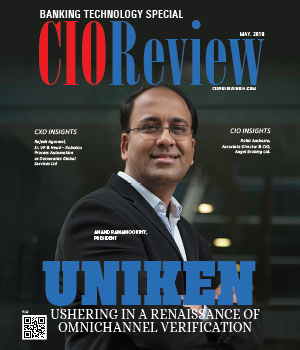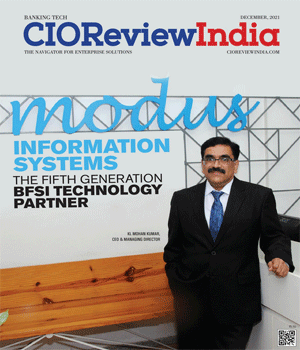
Making the Skies Safer and the Population Healthier
CIOReview Team | Tuesday, 02 June 2015, 08:50 IST
 Since I was a child, I’ve wanted to be a pilot. I finally got started last April. I’m ready for my check ride after completing the required hours of ground, in-the-air training and solo time. It’s the last thing needed to earn my private pilot’s license.
Since I was a child, I’ve wanted to be a pilot. I finally got started last April. I’m ready for my check ride after completing the required hours of ground, in-the-air training and solo time. It’s the last thing needed to earn my private pilot’s license.
Seems there’s nothing quite like flying. There’s always a lot going on, from planning the flight through to reflecting on how things went once back on the ground. It requires a lot of focus and attention to detail, but is challenging and enjoyable.
Many pilots like me starting out in a single engine Cessna learn the old school way: paper-based handbooks, checklists and charts; steam gauges; communicating with your home airport tower; and following the “see and avoid” approach. That’s keeping an eye out for other planes.
Eventually you may fly “on instruments.” You do so in a more connected world – one where you’re still “pilot in command,” but your flight is coordinated by Air Traffic Control (ATC) along the way. ATC has a lot more technology behind it than the average pilot, but the Federal Aviation Administration (FAA) is making changes that are driving technology adoption.
It seems there are similarities between aviation and Population Health, especially in ways technology and connectivity are making the skies safer and populations, meaning us, healthier. For Humana, we see population health as measurably improving the communities we serve by making it easy for people to achieve their best health.
A pilot is considered uniquely accountable, reminded by FAA regulation that he or she is “pilot in command.” They are responsible for maintaining situational awareness in the sky; flying by visual flight rules, a pilot must constantly determine which nearby planes to avoid.
"Managing one’s health isn’t much different. We make choices like what to eat, whether to exercise, whether or not to see the doctor or to follow doctor’s orders. We are the “pilot in command” of our health."
It wasn’t long ago that you’d go see a family doctor, who might order medical tests and, possibly, send you to a specialist. The office might give test results to you to bring along, they might fax them instead or wait for them to be requested. Frequently our complete medical history was kept in our heads. We navigated the health system on our own – as “pilot in command.”
So one’s medical record, probably paper-based, reflected more of a one-on-one relationship with each doctor rather than a truly complete and up-to-date medical history shared across one’s doctors. For me that seems like flying under visual flight rules. You typically only communicate with each airport’s control tower along your flight. They may know where you are, regardless, you need to always know where you are and no one other than you really knows where you’ve been, where you’re going or how to get there. You’re your own care coordinator, your own ATC of health.
The Health Information Technology for Economic and Clinical Health Act (HITECH), signed into law in 2009, was designed to promote the adoption and meaningful use of health information technology. Essentially it outlines a series of incentives and penalties associated with adoption of secure technologies that support: clinical workflow; electronic storage of clinical information; electronic exchange of that information; and automated decision support. Its intent is to use technology and connectivity to improve patient outcomes through technology-enabled care coordination in a highly interoperable world. Basically, HITECH aspires to help improve health outcomes for all.
In some respects aviation is ahead of the health care industry in using technology. Flying under instrument flight rules, meaning relying only on instruments to get you from your starting airport to destination, has quite a bit of technology behind it, including a rich history of protocols and standards. Controllers have access to filed and modified flight plans, coordinate hand-offs and share information between one another, including detailed information about an aircraft – its speed, position, altitude, ascent or descent rates and direction of flight. Automated algorithms look to identify potential collisions, the results used to proactively alert controllers about potentially dangerous situations. Basically, the ATC system helps make flying safer.
Both aviation and health care, however, grapple with an ever-rising wave of consumer technology, which holds promise for both, but presents unique challenges for each. Consumer technology, steeped in the trends of mobility, social, cloud and analytics, is opening up incredible possibilities for individuals, patients and pilots alike, to engage differently in their respective health and flying experiences. Perhaps more importantly, consumers have come to expect – demand – an easy-to-use experience tailored to them readily accessible. There is no shortage of technology-based vendors innovating platforms to enable individualized, experience-based economies.
Aviation may be somewhat ahead of the health care industry in leveraging technology and connectivity to coordinate the individual (flying) experience. That may not be too surprising given how long it’s used technology to do so and the relatively smaller number of points (ATC regions, so on) to connect. Its two primary challenges lie in the state of technology in the aircraft and required regulatory change.
A number of airworthy general aviation planes lack transponders. Transponders are used to communicate information about the plane, such as its call sign, to the ATC system for use by controllers. Much of that information, combined with radar information, is used in collision avoidance. In 2009, the FAA issued the Automated Dependent Surveillance – Broadcast (ADS-B) mandate, scheduled to take effect in 2020. Compliance requires installation of ADS-B Out capable equipment so that the sending of precise location and other information about the aircraft to ground stations and other aircraft equipped with ADS-B is possible. Aircraft with ADS-B In capable equipment allows pilots to know the speed, altitude and heading of other aircraft in their vicinity, and provide more detailed information on terrain and weather through GPS and transceivers.
Some pilots have already made the investment in ADS-B capabilities, even though compliance is still a few years away. Others are already flying aircraft that are “glass cockpit” enabled with such capabilities. While many more are combining the use of consumer technologies, such as iPads and ADS-B receivers, to augment their traditional, steam gauge-based experience in the cockpit. Regardless, increasing connectivity and greater interoperability covering areas such as flight information, terrain awareness and simulated display, real-time weather information and automated position reporting implemented seamlessly across pilots and controllers alike, should result in a more highly coordinated flight experience that is even safer than today.
One can see how other industries have already transitioned from point-to-point experiences, to fixed connected network experiences and, ultimately, virtually connected experiences. Perhaps the biggest challenge is that of ubiquitous connectivity and consequent interoperability across the health care industry. It is largely in that middle spot today – some connectivity, mostly local across bespoke networks (e.g., an integrated delivery system). There are signs it is changing, however, as demonstrated by the rise of industry-led initiatives such as CommonWell.
But to truly deliver on the promise of Population Health, connectivity and interoperability must enable the creation of virtual care coordination where the coordination of care moves closer to the primary care physician in support of the person needing care, through which the doctor delivers “plug and play” personalized care, specific to the individual, helping achieve their best health possible in a way they are most likely to engage. Consumer technologies are tremendous enablers of this potential – as they do today and should do so more in the future.
Much like the aviation industry analog, achieving the fulsome vision of Population Health may still be a few years out. Many key ingredients are already in place and use today. Connectivity and interoperability are requisites for delivering individualized, experiences. Providing those as easy-to-use, personalized experience via consumer technologies, leveraging mobile, social, cloud and analytics-based capabilities to do so is becoming table stakes. In so doing, both the aviation and health care industries are stepping up in similar, albeit separate ways – making the skies safer and the population healthier.
CIO Viewpoint
Machine Learning In Cybersecurity: The Risks &...
By Neelesh Kripalani, Chief Technology Officer, Clover Infotech
5 Major Saas Trends To Check-Out In 2021
By Vikas Bhonsle, CEO, Crayon Software Experts India
Artificial Intelligence & The Disruptive Chatbot
By Vishal Sinha, President & CIO, Tranzlease Holdings
CXO Insights
Crafting the Digital Journey in Banking
By Janifha Evangeline
Incorporating Blockchain Capabilities into...




.jpg)
.jpg)





